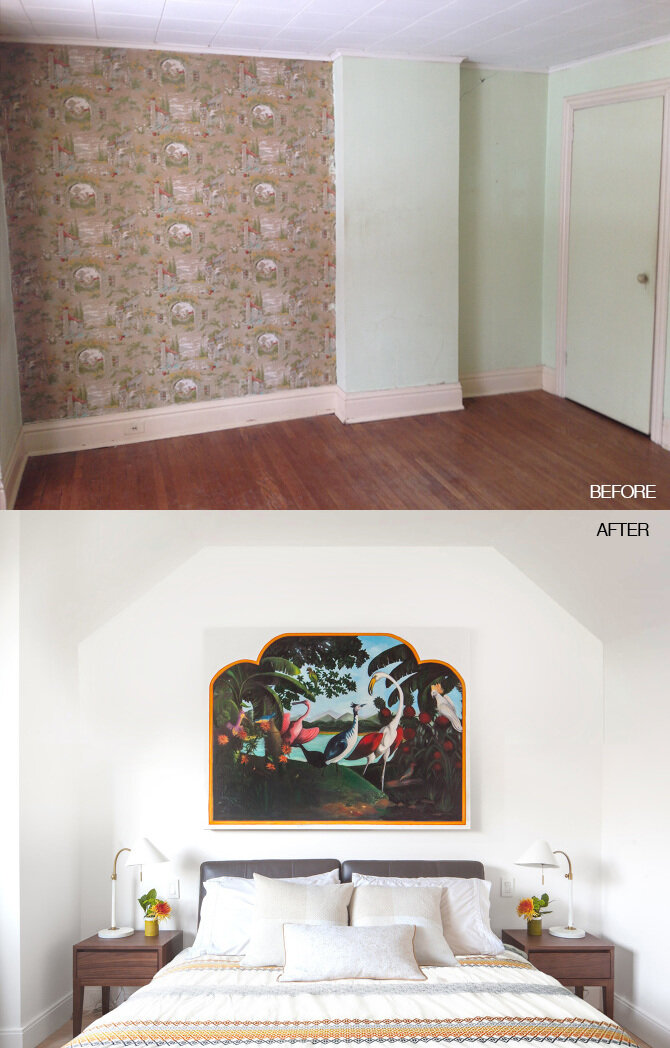EXPOSED BRICK
Let's talk about exposed brick. In recent years, it has become a polarizing design trend, with many people loving the charm, warmth, and texture it can bring to a space. On the other hand, they can chip, crumble, trap dirt, and sometimes be an absolute headache to maintain.
Our general feeling is that exposed brick is an overused strategy, and often unsuccessfully. Just because you expose a bit of brick in your Toronto home doesn't mean it will suddenly feel like a loft in New York City. However, for the benefits we listed above, we do understand the appeal of brick and we do use it in some of our projects, though specifically and thoughtfully.
In the typical Toronto house, you may find brick (with the opportunity to be exposed) in a few places: as part of the exterior wall structure, on party walls separating semi-detached or row houses, and on chimney breasts that puncture through the house vertically. Let's go through each of these scenarios one by one, and then talk about our favourite approach to exposed brick.
Exposed brick wall
EXPOSING EXTERIOR BRICK ON THE INTERIOR
Do not ever do this. Your exterior walls are your best protection against weather and extreme temperatures. If your exterior walls are made of brick, the only reason to expose them on the interior is because you are temporarily removing the plaster and lath covering them in order to build a new wood frame wall with insulation in front of the brick. We have seen houses in this city where people go crazy for the exposed brick look and are seriously damaging their building in the process. It is extremely unsustainable, energy inefficient, and frankly, just ridiculous, to expose exterior brick structure on the inside of your home.
An image during demolition of one of our current projects. Notice the brick beside the window - this is an exterior wall surface, and therefore a new frame wall with insulation will be built in front of this surface. The party walls at the side are also made of brick - see more about this condition below.
If you have to have the look of exposed brick in your home on exterior walls, please use a veneer product like this.
These kinds of products are made from reclaimed brick that has been sliced thin, put onto a mesh backer (like tile), and then requires mortar on top in order to make it look authentic. We have found them extremely convincing in application when trying to mimic the look of exposed brick.
EXPOSING BRICK ON THE PARTY WALL
While exposing this brick is safer than exposing brick on an exterior wall, remember that this is the wall separating you from your neighbour. Even when these walls are made of brick, sound and scent can travel through cracks and crevices in the wall, so be aware of this issue.
Oftentimes, trying to expose brick on the party wall opens up a can of worms. The truth of the matter is that in these houses, the brick was never meant to be seen, and so you may be surprised once you remove the plaster and lath with what you find. The bricks may not be of the best quality, or laid in a neat and tidy manner, or there may be strange sections of infilled area that you weren't expecting.
Images of one of our current projects in construction showing the status of the brick after the existing finishes were removed.
However, if you're lucky enough to have good quality brick on the party wall, then just make sure to treat it once it is exposed. The brick may require brushing, cleaning, and treating to refresh it and keep it looking clean.
EXPOSING BRICK ON THE CHIMNEY BREAST
Exposing the brick on a chimney breast is another common option for the typical Toronto home. Generally, we think this can be a good strategy, especially if the chimney breast can work in the room as a fireplace or other focal point.
Image of the exposed brick chimney breast at our Dovercourt Dwelling project.
It is important to understand the context of the chimney breast and its relationship to the room it is in. Normally, vertical elements in contrasting materials do not punctuate interior spaces, unless they have a functional purpose. This is not to say that all chimney breasts need to be used as chimneys, but more to the fact that if the there is a strong vertical brick element in a space, some thought should be given to how to integrate it into the room. If it doesn't make sense to expose it, don't be afraid to cover it up.
A before/after image of our Ritchie Rowhouse, showing the chimney breast that protrudes into the space. We turned this room into a Master Bedroom, and the chimney breast would have interfered with the layout of the space. Therefore, we packed out the walls beside it to create a flush wall surface.
FINISHING EXPOSED BRICK
Once you've found the right wall to expose, there are two main strategies to employ - leaving the brick looking natural, or painting it.
If you opt to leave it as is, use a brick sealant with a matte finish. Bare brick works well with a more 'industrial' look, so consider changing the style of any electrical faceplates along this wall to stainless steel or matte black, to compliment the natural brick.
The other approach is to paint the brick, which is often what we advocate in our projects. Painting can hide damaged or poorly laid masonry, while still providing a beautiful textured surface. White painted brick can look fresh and bright, and can make bulky brick element feel less commanding in an interior space.
A painted white chimney breast in our Ritchie Rowhouse project provides a textured surface behind a new gas stove fireplace, while still feeling integrated into the rest of the living room.








